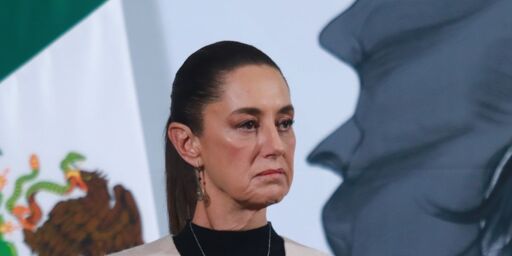- cross-posted to:
- [email protected]
- cross-posted to:
- [email protected]
The president of Mexico on Thursday expressed hope that Google “reconsiders” its decision to change its online maps to reflect U.S. President Donald Trump’s claim that he has the authority to change the name of the Gulf of Mexico.
Shortly after taking office, Trump issued an executive order announcing he was changing the name of the body of water to the Gulf of America.
For U.S. users of Google Maps, the gulf was listed as the Gulf of America as of Thursday. Google, whose CEO attended Trump’s inauguration along with other tech moguls, said last month it has “a long-standing practice of applying name changes when they have been updated in official government sources.”
But Mexican President Claudia Sheinbaum warned Thursday that her government “will file a civil suit” against Google if it does not revert back to labeling the international body of water the Gulf of Mexico.



So you are gonna have to provide a source explaining how the president using an executive order to rename international water is “policy” that Google must follow.
They you’ll have to explain why I, as a Canadian, have to see this stupid renaming in parentheses.
If the US truely doesn’t have a system beyond “once the president orders it, it’s renamed.” That’s their problem but I don’t give a fuck what they call things and I don’t know why google thinks I should.
Exactly
Here you go;
American University Law Review (2009) - The Limits of Executive Power:
There’s no conflict and therefore within the power of the executive branch.
It’s the executive branch. It would be the same as if Congress did the same, and passed a law saying “The Gulf of Mexico is now the Gulf of America.” There’s no source required, it’s literally how the US Government works, but if you want one; American University Law Review (2009) - The Limits of Executive Power:
There’s no federal law establishing the name of the Gulf of Mexico, so there’s no conflict with the first limitation. No one in Congress is willing to stop him, so no conflict with the second. And there’s no conflict with existing congressional legislation, so there’s no conflict with the third. So therefore the executive order is within the power of the executive branch.
Because Google is a US company and operates within the US, it has to follow US policy. The President just changed US policy to change the name of the Gulf of Mexico… So they either have to comply or be sued by the executive for not following US policy–which they’ll lose.
Because again, Google is a US company. So if you want to see Gulf of Mexico again, use any map provider that isn’t from a US company.
That’s an extreme oversimplification of what’s going on here. But it kinda outlines how important it is to elect good people, huh?